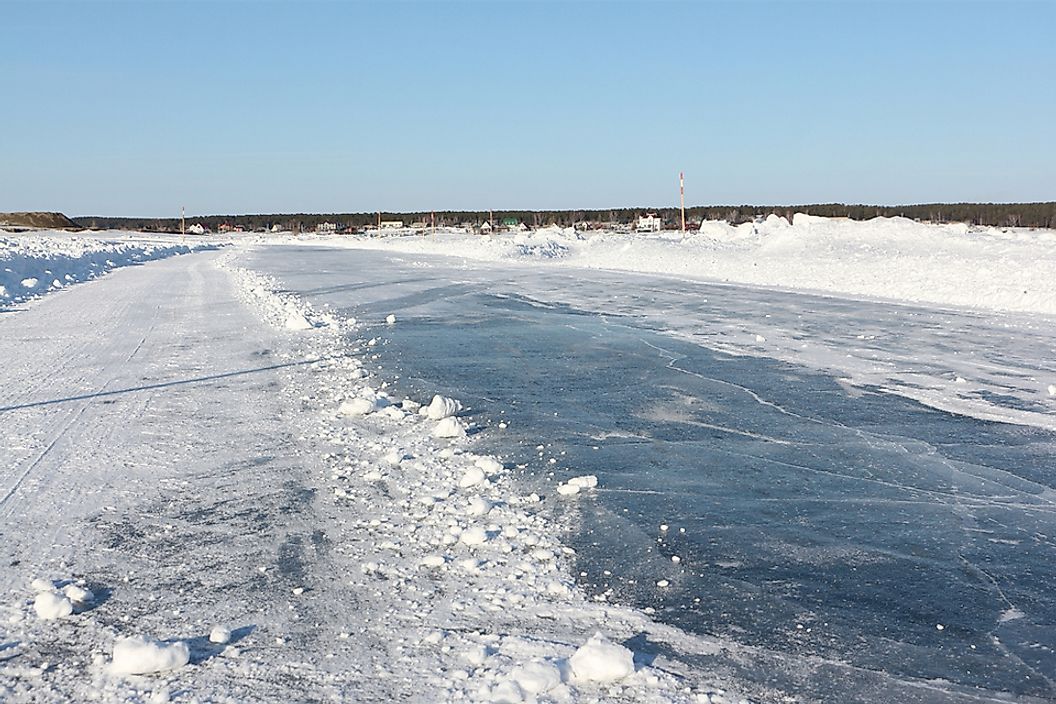Ice Roads Around the World

Ice roads are winter roads that run on top of naturally frozen water bodies such as rivers, lakes, seas, and even parts of oceans. These roads allow access to remote and isolated locations during the winter season. Most of these areas lack permanent road access. Ice roads reduce the cost of transportation as they are cheaper than air freight, while also allowing for the movement of heavy objects. Ice roads provide driving surfaces in most areas between December and April, when the ice is thick enough.
Canada
The first ice roads in Canada were built in 1930s, mostly in northern parts of the country, and were used by caterpillar sleds to pull heavy loads. These were convenient and used when loads were too heavy for air transport or when soils were too boggy. In Canada's Northwest Territories, there are only about 570 miles of paved roads, and therefore most transport is by air. Isolated regions become road-accessible only during winter, when ice roads cover about 3,300 miles. The most notable ice road was the 177 mile long Tuktoyaktuk Winter Road between Tuktoyaktuk and Inuvik, which closed permanently at the end of the 2016-2017 winter season, before the opening of an all-season highway. The Mackenzie Valley Winter Road is 405 miles long and connects five communities. Other ice roads include the Inuvik-Aklavik Ice Road, which has a length of about 73 miles and an average of 54 vehicles a day, and the Wrigley-Fort Good Hope Winter Road, which is about 300 miles long and averages 85 vehicles per day.
Estonia and Finland
The Estonian Road Administration and the Finnish Transport Agency manage and maintain ice roads in Estonia and Finland, respectively, during the winter season. In Estonia, there are various ice roads with varying lengths. The ice road between Rohukula and Heltermaa is 16.5 miles long and joins the mainland to Hiiumaa, while the Tarkma-Triigi ice road between Saaremaa and Hiiumaa measures 9.0 miles. These roads have a speed limit of 16 miles per hour and a weight limit of about two tons. When ice roads open in Finland, they are public roads, the longest being the Lake Pielinen crossing which measures 4.3 miles. The Finnish Transport Agency opens ice roads when the ice is at least 16 inches thick. The ice roads in Finland have a speed limit of 31 miles per hour, a weight limit of 3 tons, and overtaking and stopping are prohibited.
United States
The U.S. has a variety of ice roads, including one on Lake Superior which has a length of about two miles and links Bayfield, Wisconsin to La Pointe, Wisconsin. In Alaska, a 25-mile ice road serves an oil field on the Arctic Ocean and has a speed limit of 10 miles per hour. Another ice road in Alaska runs for a length of 68 miles on the Beaufort Sea and connects Prudhoe Bay and Point Thompson. A seasonal ice road joins Alpine oil field with Kuparuk Oil Field, as well as connecting to Nuiqsut village, and has a length of about 31 miles.
Other Ice Roads
In Sweden, the Lulea Archipelago measures 9.3 miles long, and is the longest in the nation
. The Swedish Road Administration manages and maintains the country's ice roads, and only opens them when the ice is more than 7.9 inches thick. These roads have restrictions in terms of gross weight, axle, bogie, as well as a speed limit of 19 miles per hour. In Norway between December and April, the Tana River has two ice roads with a 2 ton weight limit. Other regions that have ice roads include Russia, China, and Antarctica, which has the South Pole Traverse that stretches about 870 miles.











